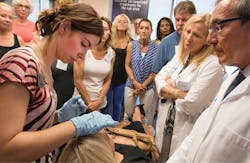How do dentists compare as health-care professionals when it comes to knowledge and skill in the oral and maxillofacial areas? How does our training in the head and neck region compare to that of other medical professionals? Are we just teeth mechanics, or are we real doctors? As president of the American Academy of Facial Esthetics (AAFE), which trains medical and dental professionals in the use of Botox and dermal fillers for facial esthetics and facial pain treatment, I find myself in a unique position training dental professionals alongside physicians, plastic surgeons, nurse practitioners, and physicians’ assistants.
From my experience training more than 15,000 health-care professionals over the last 10 years in the use of Botox, dermal fillers, trigger-point therapy, solid-filler PDO (polydioxonone) threads, and other therapies, I can confidently say that dentists’ knowledge of the head and neck match or surpass that of most physicians, including dermatologists and plastic surgeons. You don’t have to take my word for it. The AAFE faculty—which comprises various physicians, nurses, and dentists—will agree wholeheartedly that dental professionals have the skills to deliver outstanding treatment outcomes with Botox and dermal fillers.
Dr. Louis Malcmacher teaches dentists to perform injections at an AAFE live-patient training course.
This is why I found an article in a recent Journal of the American Dental Association disappointing. The article was an excellent review of different treatment options for awake bruxism, and it was written by well-known dental professionals who have spent their careers teaching dentists to perform complex restorative and esthetic dentistry. The authors describe many ways to treat destructive forces of bruxism, ranging from simple to comprehensive. Surprisingly, when it comes to giving Botox to patients for bruxism, the authors suggest dentists refer patients to medical practitioners such as physicians and plastic surgeons.
I was shocked! It is pretty obvious that the authors are not familiar with what Botox can accomplish, how it’s delivered, and how Botox is now an integral part of general dentistry. Botox and dermal filler treatments are routinely used in restorative dentistry, implant dentistry, periodontics, endodontics, TMJ treatment, orofacial pain treatment, orthodontics, fixed and removable prosthodontics, and esthetic dental cases.
I can tell you thousands of AAFE members give Botox injections into head and neck muscles routinely every single day. I can also tell you of numerous physicians, including neurologists, dermatologists, and plastic surgeons, who inject Botox regularly but will not inject into masseter and temporalis muscles, which is routine for trained dentists treating bruxism, TMJ, and orofacial pain.
The same week this article was published, I received an e-mail from an outstanding AAFE member in Georgia, BriAnna Schraw, DMD, who described a recent experience with a patient she had treated with Botox for orofacial pain and migraines. About three weeks after treating the patient, her office received a request for the patient’s records from a neurology office in California. The neurologist asked to speak to the dentist.
The neurologist started the conversation with, “So I understand you are a dentist?” Dr. Schraw answered, “Yes.” The neurologist asked, “How many therapeutic cases have you treated?” and Dr. Schraw responded, “Many.” She finally asked the neurologist what this call was about. The neurologist said, “I’ve treated this patient for her migraines for the past three years, and she faithfully comes for her appointments every four months. She was in your area for the birth of her grandchild, and the trip coincided with her four-month Botox treatment. The patient told me I had to find out how you did the injection treatment because your treatment worked better for her than any that I’ve given her in the past three years. She also told me that she wants me to use your treatment plan, and if I won’t do that, she’ll fly back to see you and continue to have you provide her migraine injections.”
This story shows how properly trained dental professionals are highly capable of delivering outstanding treatment outcomes with Botox and dermal fillers on par with—or better than—most medical professionals because the face, head, and neck are the primary areas of our expertise. Over the last 10 years, AAFE dentist members have certainly proven dentists can provide these treatments with the highest level of safety and efficacy for facial esthetics, TMJ, and orofacial pain. It’s time for you to get trained today.
Author’s note: Go to FacialEsthetics.org to sign up for a free monthly e-newsletter or to access information about live-patient Botox and dermal fillers training, frontline TMJ and orofacial pain training, frontline bruxism therapy, dental sleep medicine, and Medicare and medical insurance for every dental office.
Louis Malcmacher, DDS, MAGD, is a practicing general dentist and an internationally known lecturer and author. Dr. Malcmacher is president of the American Academy of Facial Esthetics (AAFE) and serves as a consultant to STATDDS. Contact him at (800) 952-0521 or [email protected].
About the Author

Louis Malcmacher, DDS, MAGD
Louis Malcmacher, DDS, MAGD, is a practicing general dentist and an internationally known lecturer and author. He is the president of the American Academy of Facial Esthetics (AAFE). You can contact him at (800) 952-0521 or [email protected]. Go to facialesthetics.org for information about live-patient Botox and dermal fillers training, solid-filler PDO thread lifts, frontline TMJ and orofacial pain training, dental sleep medicine, bruxism therapy and medical insurance, and to sign up for a free monthly e-newsletter.

